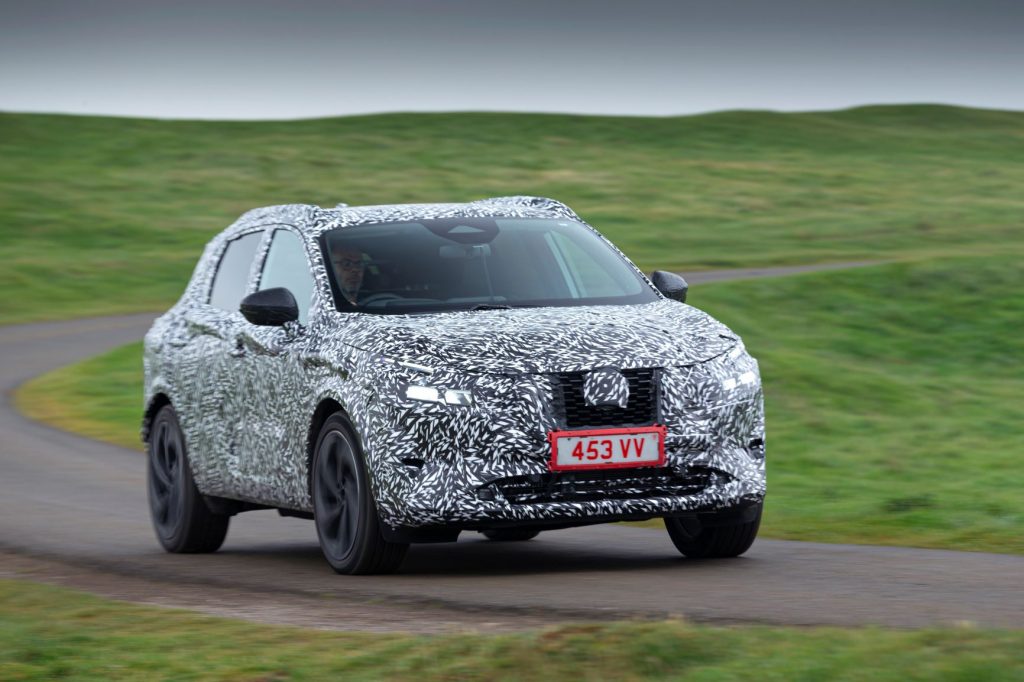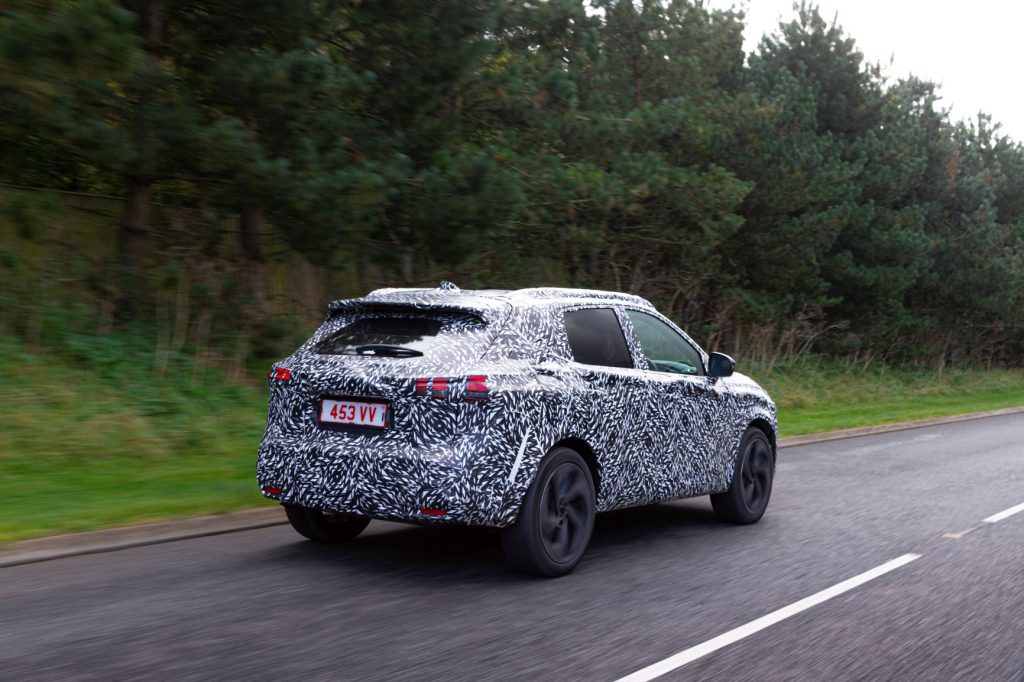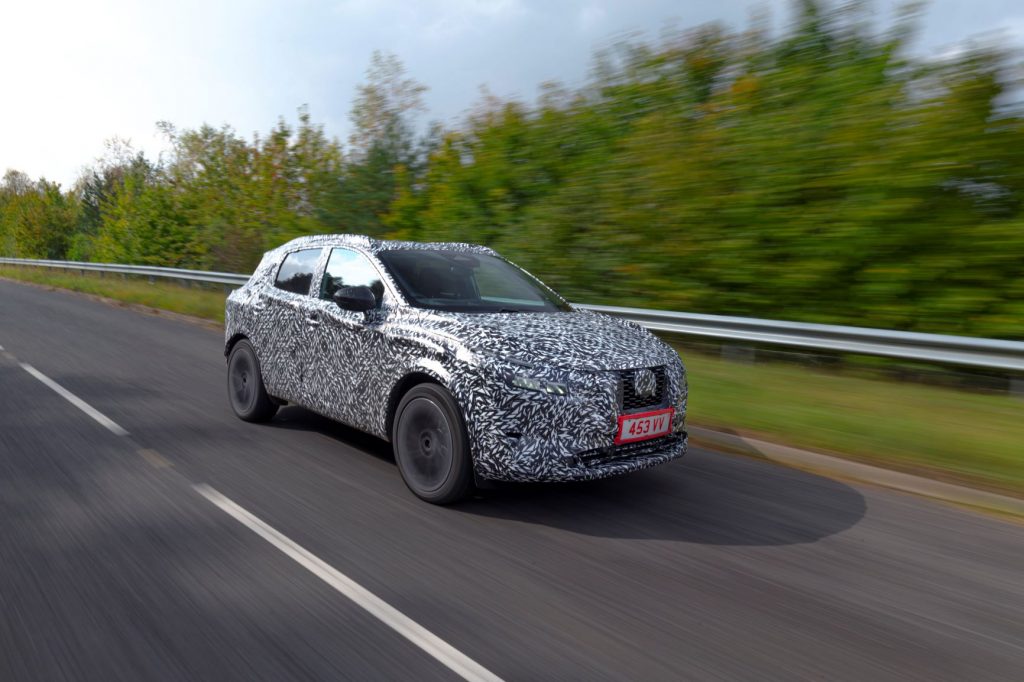NISSAN’S QASHQAI FOLLOWS ITS own design path, with some people just loving its quirkiness, and others finding it a step too far.
Final preparations are well under way for the introduction of the third generation of the compact crossover that changed the face of the European car market and spawned many imitators.
Prototypes of the all-new model are racking up the testing kilometres on European roads in anticipation when it goes on sale in 2021.
The all-new Qashqai will build on its position as the pioneer of and benchmark in the medium-crossover segment in Europe since 2007. Underpinning the new Qashqai is the new Alliance CMF-C platform.
The current Qashqai, which went on-sale in Europe in 2014, has sold over one million units since its introduction.
Like its predecessors, the styling of the new Qashqai was led by the team at Nissan Design Europe, based in central London (UK), while its engineering was led by Nissan Technical Centre Europe, situated in Cranfield, Bedfordshire (UK).

CMF-C platform
The new Qashqai is the first new model in Europe to use the CMF-C platform, which represents a state-of-the-art automotive structure and technology architecture.
Central to the engineering concept was to retain the current Qashqai’s proportions, which are “just right” and key in its success, meaning it comfortably navigates urban roads and fits comfortably in parking spaces, while also giving excellent interior space.
In terms of construction, the body in white makes use of more lightweight material, as well as advanced stamping and welding techniques to increase strength but to also reduce weight. For the first time, the rear hatchback door on the Qashqai is now made of a composite material, which saves 2.6kg.
The use of Nissan’s Ultra High Strength Steel application (UHSS) has increased by 50 percent in the structure of the new Qashqai. The UHSS material ensures the highest possible tensile strength in the body structure where it is needed, as part of the crash structure, for example – but without a significant weight penalty. Traditionally, higher tensile strength materials pose problems in welding or joining to other parts of the structure. With the Qashqai’s body in white, structural bonding has been used to form a high strength reinforcement and bond where the A-, B- and C-pillars join the roof and floor pan.
The front and rear doors, front fenders and hood, are all now made of aluminium, which offers a weight-saving, when taken all together, of 21kg over the out-going Qashqai’s body in white.
The base structure – the “back bone” – of the CMF-C platform has been updated to a more homogenous shape, in order to better transmit an impact through the structure. This will have the effect of the structure absorbing the energy more effectively in the crumple zones, reducing the potential load transmitted to the occupants in the event of an accident.
The net advantage for customers, thanks to the advanced manufacturing techniques, is that the overall body in white is lighter by 60kg and 41 percent stiffer than the out-going model. This translates to refinement, ride comfort and driving response from a higher segment, plus exceptional security in the event of an accident – as well as having benefits to the car’s overall efficiency.

New suspension and steering design
The new CMF-C platform boasts torsional rigidity of vehicles from a higher segment, allowing the suspension to remain precisely located, ensuring positive responses to steering inputs and a more solid feel when driving on rough roads.
Thanks to the CMF-C platform, the new Qashqai has an updated Macpherson strut set-up at the front and at the rear. For two-wheel drive Qashqai specified up to and including 19-inch wheels, rear suspension is a torsion beam configuration. For 20-inch wheels and all-wheel drive versions, it will be equipped with an advanced multi-link set-up.
The torsion beam installation offers improved bump absorption and road-noise suppression, resulting in a composed and quiet drive on all road surfaces. Key to its wide-ranging abilities is the change in spring and damper to a vertical alignment. This allows the spring and damper to work in their optimal stroke range, maximising their effectiveness for more controlled response to bumps and shocks in the road and to minimise rebound for a settled, composed ride, while maintaining excellent anti-roll performance through changes of direction.
The advanced multi-link rear suspension configuration offers a best-in-segment balance between ride comfort and dynamic response. It is now mounted to the sub-frame by bushes, which reduce road noise and vibrations transmitted from the road.
The power-steering set-up has been upgraded for improved response, better feel in the centre of the steering range and reduced friction.

Innovation for efficiency
The new Qashqai will offer customers two powertrain solutions – a flexible and efficient 1.3-litre petrol engine with mild hybrid technology, while Nissan’s innovative e-POWER electric motor driven system will bring the exciting instant and linear acceleration EV feeling to the Qashqai, without the range concerns.
With the more torsionally rigid body-in-white structure, the drive for optimal efficiency in the new Qashqai has been at the heart of the entire development process. And that drive for efficiency extends to the use of the flexible 1.3-litre petrol engine which will be available in two power outputs, both combining responsive characteristics with frugality and low emissions. (Full technical details and specifications of this powertrain will follow closer to its market introduction)
Two additional examples of the lengths Nissan’s engineers have gone to in order to optimise the new Qashqai’s efficiency are the flat floor, which ensures the smoothest possible airflow underneath the car – and also the active grille shutter, which remains closed to ensure the air passes around the front of the car as cleanly as possible. It only opens when the cooling needs of the engine require it, allowing extra air to enter the radiators in order to cool it.
The front styling of the car also generates an air curtain that directs the air flow around to reduce the drag generated by the front wheels.
The 1.3-litre petrol engine has been extensively updated to include a mild hybrid system. The 12v system incorporates a separate lithium battery installation mounted under the floor and belt driven generator to harvest braking energy. This allows the engine’s systems to run on harvested energy, extending the duration of the stop/start function which reduces the engine’s overall CO2 emissions. Additionally, it allows coasting and also offers torque support under acceleration.
e-POWER
The new Qashqai will represent the best of Nissan’s innovative spirit called Nissan Intelligent Mobility. It will bring the first deployment of Nissan’s innovative ePOWER drive system to Europe. A unique Nissan innovation, the e-POWER system offers full electric motor drive, meaning that the wheels are completely driven by the electric motor. e-POWER comprises a high-output battery and the powertrain which is integrated with petrol engine, power generator, inverter and a motor. In conventional hybrid systems, the wheels are driven by an electric motor and a petrol engine. However, in the e-POWER system, the petrol engine is not connected to the wheels; it simply charges the battery. And unlike a full EV, the power source is the engine, rather than just the battery.
The key difference compared with other conventional hybrids is that the electric motor is the size of one typically found in a pure EV, giving the instant acceleration response which is so popular among EV customers. The engine-driven generator maintains the battery charge, but can also provide electricity directly to the motor for additional power. The engine operates at an optimal RPM range promoting maximum fuel efficiency while being carefully tuned to minimise noise and provide a natural, connected feel during hard acceleration.
e-POWER brings instant and linear acceleration, delivering a fun-to-drive experience but without the range anxiety. This is the perfect transition into EV driving especially for high mileage drivers who will love the combination of convenience and refinement, as well as the car’s eco-efficiency.
Upgraded ProPILOT driver assistance
The new Qashqai will be equipped with the next generation of ProPILOT driver assistance, bringing greater driver support in a wider array of circumstances. Called ProPILOT with Navi-link, the system has been designed to reduce fatigue and stress while driving, while being very intuitive to use.
ProPILOT with Navi-link is able to accelerate and brake the vehicle within a single-lane on a highway. The system can accelerate the vehicle to cruise at a set speed, and can brake the vehicle down to 0 km/h in heavy stop-start traffic. The system is able to resume automatically if the vehicle has been stationary for less than three seconds and the traffic in front of the car moves away.
The steering system and the camera are constantly updating the vehicle’s position, helping the car to stay centred within the lane while maintaining a pre-determined speed but with the capability to adapt and maintain a safe distance to the car in front.
On the all-new Nissan Qashqai, the updated system is now able to adapt the car’s speed according to additional external circumstances: when the car crosses to a lower speed limit zone on the highway, the system is able to read road signs and take into account navigation system speed limit data to slow the Qashqai to the appropriate speed, meaning the driver doesn’t need to adjust the cruise control speed manually.
The system can also use data from the navigation system to adjust the speed for approaching curves or exit ramps that have a tighter radius.
Furthermore, ProPILOT with Navi-link can now communicate with the Qashqai’s blind-spot radars to help intervene with a steering input correction to help prevent a lane-change manoeuvre if there is a vehicle in the blind-spot zone.
Other upgrades include a “flank protection” warning for urban situations, which alerts the driver of the risk of contact with an object on the side of the vehicle, typically when turning into a supermarket parking space. And the new Qashqai can also intervene to prevent a collision upon reversing from the space thanks to an upgrade on the existing Moving Object Detection alert, applying the brakes to stop the car if a moving obstacle is detected nearby.
ProPILOT with Navi-link will be available from the mid-level N-Connecta grade to enable the majority of Qashqai drivers to enjoy this unique advanced technology, epitomising Nissan’s brand promise of “innovation for excitement”.
Intelligent LED headlights
The current Qashqai has been equipped with LED lights on upper grades since its launch in 2014, and those on the top-grade Tekna version swivel to follow the road in response to steering wheel inputs, with exceptional clarity thanks to the powerful projectors that provide a strong, even beam.
For the new Qashqai, Nissan’s engineers developed an advanced headlight system that adapts the shape of the beam according to the road conditions and other road-users. The beam is divided into 12 individual elements that selectively deactivate upon detection of an oncoming vehicle. Thanks to this innovation, it can project a brighter beam further and wider, but the shape effectively changes so oncoming road-users will not be dazzled.
Once we have tested and assessed the new Nissan Qashqai, seniordriveraus will bring you a comprehensive review, including everything the over-50 driver needs to know.
